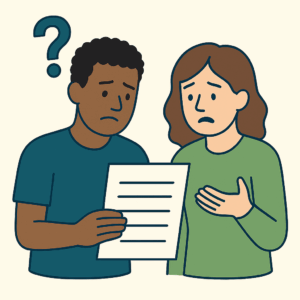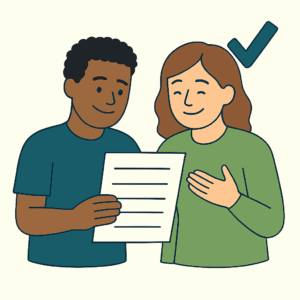What Does ‘Accessible Information’ Mean?
We use the word ‘access’ in lots of different ways. It can mean getting into a place, finding something, or being able to understand something. When we talk about accessible information, we’re mostly talking about how easy it is to understand and use information we get.
Different types of access
- Physical access means being able to get something. For example, walking into a building, opening a document, or watching a video. Sometimes we do this ourselves (like searching online), and sometimes someone helps us (like sending us a file or using a ramp).
- Understanding access means being able to make sense of what we see, hear, or read. Just because we have the information doesn’t mean we understand it.
Why understanding matters

Accessible information is about understanding. It’s not enough to just have the information. We need to be able to use it. For example:
- A medical report might be full of hard words or technical language.
- A video might not have captions, so some people can’t follow it.
- A chart or infographic might be confusing or unclear.
Even if the information is there, it might not be helpful unless it’s easy to understand.
How ‘accessible information’ links to health literacy
Health literacy means being able to find, understand, and use health information to make good choices about our health. This could be about when to go to the doctor, instructions for taking medicine, or choosing healthy foods.
If health information is hard to understand, people might:
- Feel unsure or lack confidence about what to do.
- Misunderstand important steps in their care.
- Make choices that are unsafe or unhelpful.
That’s why accessible information is so important in health care. It helps people:
- Know what’s happening with their health.
- Ask questions and speak up.
- Make decisions based on good advice and recommendations.
- Make good choices about their health, money, or education.
For example, a hospital might give out a brochure about surgery. If the brochure uses hard words or medical terms, some people might not understand it. But if the hospital uses plain language, pictures, or easy-to-read formats, people are more likely to understand and feel confident.
Just like a ramp into a building, accessible information helps everyone. Not just people with disabilities or low literacy. It makes health decisions safer and easier to navigate.

How to make information more accessible
Making information accessible means thinking about how different people understand things. Some ways to do this include:
- Using plain language.
- Sharing information in different formats (like easy-to-read, audio, or video with captions).
- Thinking about people’s cultural and education backgrounds, languages, and support needs.
- Asking real people to read the information to see if they understand or have suggestions to improve it.
Acknowledgement: Written with AI support